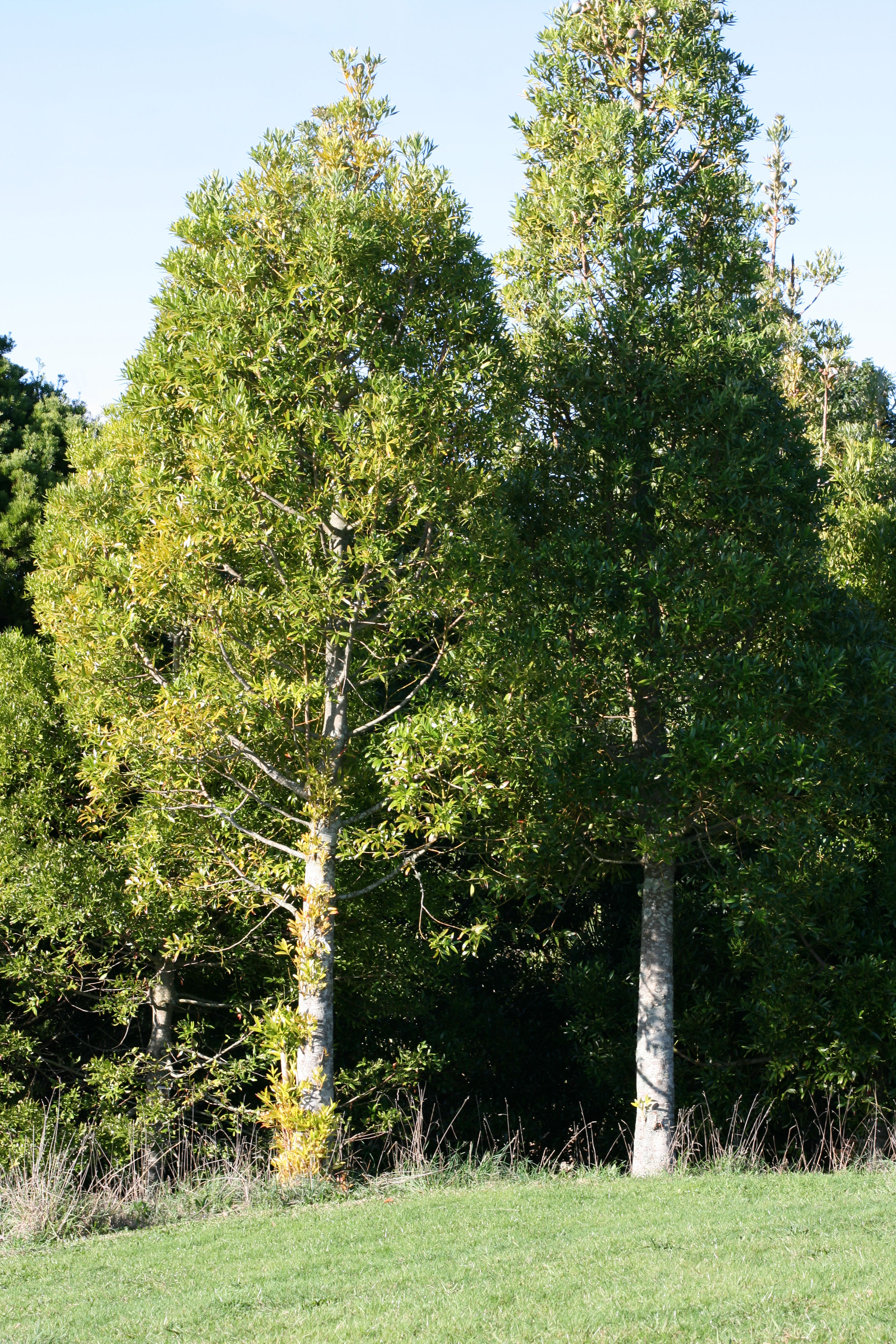- Agathis macrophylla
Taxobox
name = "Agathis macrophylla"

image_caption = Young trees at Auckland, New Zealand
status = LR/nt | status_system = IUCN2.3
regnum =Plant ae
divisio =Pinophyta
classis = Pinopsida
ordo =Pinales
familia =Araucariaceae
genus = "Agathis "
species = "A. macrophylla"
binomial = "Agathis macrophylla"
binomial_authority = (Lindl.) Mast.
synonyms = "Agathis obtusa"
"Agathis silbae"
"Agathis vitiensis""Agathis macrophylla" known as the Pacific Kauri, is a coniferous tree native to the islands of the southwestern
Pacific Ocean in tropical humid lowlands and lower montane regions, notably inFiji ,Vanuatu , theSanta Cruz Islands , and theSolomon Islands . The Pacific Kauri is one of the largest and fastest growing species in its genus, and is important inforestry throughout the humid tropics. ["Agathis macrophylla" was previously known as "A. obtusa" in Vanuatu and "A. vitiensis" in Fiji, but these are now regarded as 'non-preferred names' (Thompson 2006:2). Also now included in "A. macrophylla" is "Agathis silbae" of Santo Island, Vanuatu.]Description
system is deep and strong, and the trees are highly wind resistant.
The leaves are green and glossy, elliptical to lanceolate, 7-15 cm long and 2-4 cm wide. They are borne on short petioles and held in a decussate pairs, but twisted so they lie in one plane. Leaves in the shade, of juvenile trees, and of individuals growing in wetter regions, tend to be larger.
Male cones of "A. macrophylla" are elliptical and measure roughly 2-5 cm long at pollen shed. The short pollen cones help distinguish this species from related "Agathis" species. Female (seed) cones are globular, 8-13 cm across, and are borne on short
wood y stalks. The majority of the cone crop matures early to mid February, as the cones turn brown and release the wingedseeds , which are small, flattened, and attached to a wing about 3.5 cm in length. Wind dispersal is very efficient; seeds have been known to travel tens ofkilometre s in the wind, and may even travel hundreds of kilometres during thetropical cyclone s that occur frequently in the species' range.Ecology
" spp. in Fiji.
It is one of the fastest growing species in its genus, capable of growing 1-1.5 metres in height annually in lightly shaded to open areas, where growth is fastest. The species is fairly shade tolerant, especially in the seedling stage, though growth is slow under suppression. Strong root systems enable mature trees to withstand cyclones and seed rapidly into gaps. The species on the whole is long lived, capable of reaching ages of 300-1000 years.
Uses
"A. macrophylla" is a valued commercial timber species, and its wood is much sought after for many uses. The wood is a cream to gold colour (mature
heartwood is a lustrous brown) and much appreciated in the timber industry, particularly as a surfaceveneer . The dry wood has a density of approximately 540 kg/m³.Pacific Kauri is a valuable tree throughout the southeastern Pacific (Melanesia). The timber is frequently used for house construction,
canoe carving, andtotem pole construction. Smoke from the resin is used as a black dye for hair, clothes and tattoos, and the leaves are used in traditional medicine.External links
* [http://culturesheet.org/araucariaceae:agathis:macrophylla Agathis macrophylla] on CultureSheet.org
* [http://www.conifers.org/ar/ag/vitiensis.html "Agathis macrophylla"] at the Gymnosperm Database.Notes
References
*IUCN2006|assessors=Conifer Specialist Group|year=2000|id=34321|title=Agathis macrophylla|downloaded=26 November 2006
*cite web |author=Lex J. Thompson |date=2006 |title=Agathis macrophylla (Pacific kauri), ver. 1.2. |work=Species Profiles for Pacific Island Agroforestry |publisher=Edited by C.R. Elevitch. Permanent Agricultural Resources (PAR) Holualoa, Hawaii |url=http://www.agroforestry.net/tti/Agathis-Pacific-kauri.pdf|accessdate=2007-08-07
*cite web |author=R. Thaman, C.R. Elevitch, K.M. Wilkinson, (eds). |date=2000 |title=Multipurpose trees for agroforestry in the Pacific islands |work=Agroforestry Guides for Pacific islands #2|publisher=Permanent Agricultural Resources (PAR) Holualoa, Hawaii |url=http://www.agroforestry.net/pubs/Multspec.pdf |accessdate=2007-08-10
Wikimedia Foundation. 2010.
